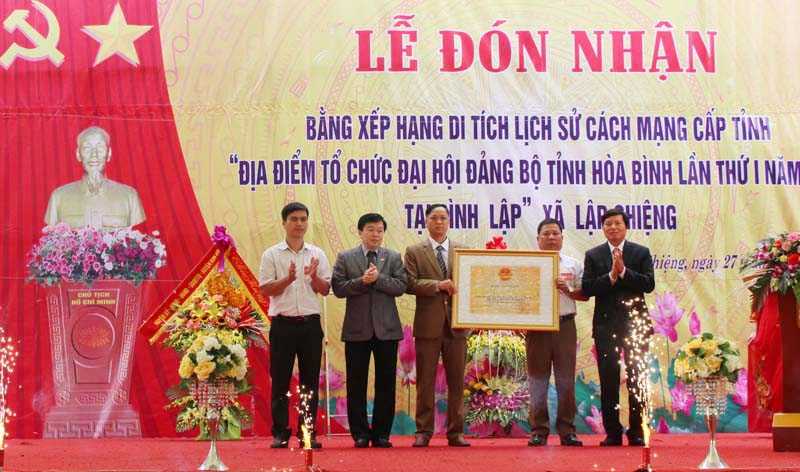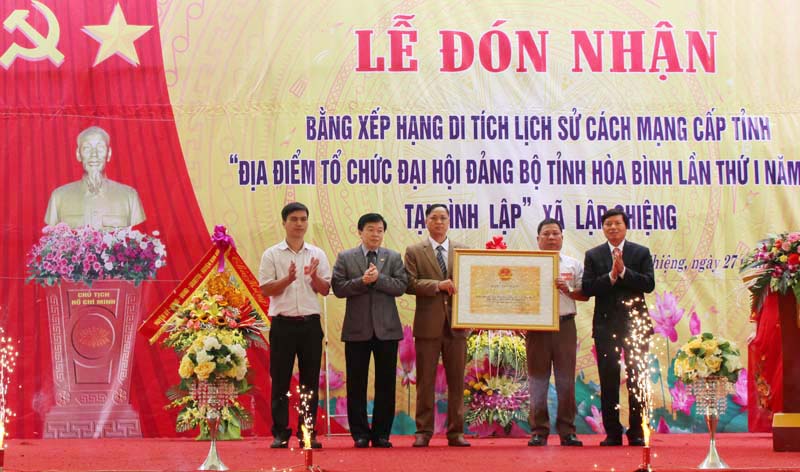
(HBO) - The People’s Committee of Kim Boi district on March 27 organised a ceremony to receive the provincial revolutionary historical relic status for the Lap communal house, where the first Congress of the Party Committee of Hoa Binh province was held in 1948.
![]()
 Vice Secretary of the provincial
Party Committee and Chairman of the provincial People’s Council Tran Dang Ninh and Vice Chairman of the
provincial People’s Committee Nguyen Van Chuong present the certificate to representatives
of the Party Committee, authorities and people of Lap Chieng commune.
Vice Secretary of the provincial
Party Committee and Chairman of the provincial People’s Council Tran Dang Ninh and Vice Chairman of the
provincial People’s Committee Nguyen Van Chuong present the certificate to representatives
of the Party Committee, authorities and people of Lap Chieng commune.
The Lap communal
house in Lap Chieng commune was built in the late 19th century. The wooden
communal house consists of one compartment and two lean-tos, with an altar called
Cung So worshiping the two tutelary gods Mr Moi and Mrs Nanh, and some
worshipping objects.
During the period towards the general uprising to seize power in August 1945,
the communal house was the gathering place of the Viet Minh, Luong Son team. From
May 21-25/1948, the Lap communal house was selected as a place to host the first
Congress of the provincial Party Committee, which saw the participation of 120 delegates
representing 333 Party members in 37 Party cells. The first Congress of the
provincial Party Committee had great political significance in the context of complicated
developments of resistance situation in the locality.
With its historical values and important political
significance, the communal house in Lap Chieng commune was recognised as the
provincial revolutionary historical relicsiteunderDecision No. 24-QD/UBND dated on January 5, 2019 by the provincial People’s
Committee.
Speaking
at the ceremony, Vice Secretary of the provincial Party Committee and Chairman
of the provincial People’s Council Tran Dang Ninh said he believed that the
locality would continue to uphold its revolutionary
tradition and made stronger change in socio-economic development, while conserving
cultural values. He hoped the local authority to work hard to uphold historical
values of the relic site.
With an increasingly vibrant and widespread emulation movement aimed at building cultured residential areas and cultured families, Yen Thuy District has been making steady progress toward improving both the material and spiritual well-being of its people, while fostering a civilized, prosperous, beautiful, and progressive community.
Once lacking recreational spaces and community facilities, Residential Group 2 in Quynh Lam Ward (Hoa Binh City) has recently received attention for the construction of a new, spacious, and fully equipped cultural house. The project followed the model of state support combined with public contributions in both labor and funding.
The "All people unite to build cultural life" movement, which has been effectively integrated with Kim Boi district’s socio-economic development goals, is fostering a lively spirit of emulation across local residential areas, hamlets, villages, public agencies, and enterprises. In addition, through the initiative, traditional cultural values are being preserved and promoted, while community solidarity and mutual support in poverty reduction and economic development are being strengthened.
A working delegation of the Hoa Binh provincial People’s Committee led by its Permanent Vice Chairman Nguyen Van Toan on June 11 inspected the progress of a project to build the Mo Muong Cultural Heritage Conservation Space linked to tourism services in Hop Phong commune, Cao Phong district.
Born and growing in the heroic land of Muong Dong, Dinh Thi Kieu Dung, a resident in Bo town of Kim Boi district, in her childhood was nurtured by the sweet lullabies of her grandmother and mother. These melodies deeply imprinted on her soul, becoming an inseparable part of her love for her ethnic group's culture. For over 20 years, this love for her hometown has driven Dung to research, collect, and pass down the cultural values of the Muong people to future generations.
In the final days of May, the Ethnic Art Troupe of Hoa Binh Province organized performances to serve the people in remote, mountainous, and particularly disadvantaged areas within the province. These were not just ordinary artistic shows, but they were the meaningful journeys aimed at spreading cultural values, enhancing the spiritual life of the people and contributing to the preservation of ethnic minority cultural identities.



 Vice Secretary of the provincial
Party Committee and Chairman of the provincial People’s Council Tran Dang Ninh and Vice Chairman of the
provincial People’s Committee Nguyen Van Chuong present the certificate to representatives
of the Party Committee, authorities and people of Lap Chieng commune.
Vice Secretary of the provincial
Party Committee and Chairman of the provincial People’s Council Tran Dang Ninh and Vice Chairman of the
provincial People’s Committee Nguyen Van Chuong present the certificate to representatives
of the Party Committee, authorities and people of Lap Chieng commune.